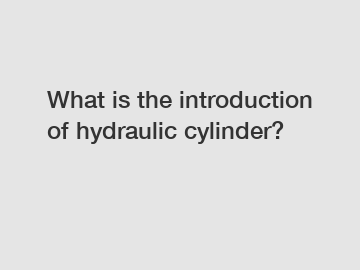What is the introduction of hydraulic cylinder?
Hydraulic cylinders are mechanical devices that are extensively used in various industries for generating linear force or motion using hydraulic pressure. They play a vital role in a wide array of applications, such as construction equipment, agricultural machinery, manufacturing machinery, and even in the aerospace industry. The primary function of a hydraulic cylinder is to convert the energy derived from fluid pressure into linear force and motion. This article will provide an in-depth understanding of hydraulic cylinders, their components, working principle, and applications.
Components of Hydraulic Cylinders.
Hydraulic cylinders consist of various components that work together to facilitate the conversion of hydraulic pressure into mechanical force and motion. Some of the key components include:

Cylinder Barrel: The cylinder barrel, also known as the cylinder tube, acts as the main body of the hydraulic cylinder. It provides support to the other components and contains the piston and rod assembly.
Piston and Piston Rod: The piston is a cylindrical component that fits inside the cylinder barrel and divides it into two chambers, namely the rod end and the cap end. The piston rod is attached to the piston and extends through one end of the cylinder barrel to transmit force.
Cylinder Head and Cap: The cylinder head is located at the closed end of the cylinder barrel, while the cylinder cap is located at the open end. They seal the cylinder and retain the hydraulic fluid within the chamber.
Seals and Bearings: Seals are used to prevent leakage of fluid and to enhance the performance and longevity of hydraulic cylinders. Bearings are used to reduce friction during the movement of the piston and rod.
Working Principle of Hydraulic Cylinders.
Hydraulic cylinders work on the principle of Pascal's law, which states that when pressure is applied to a fluid in a confined space, the pressure is transmitted equally in all directions. In the case of hydraulic cylinders, hydraulic fluid is pumped into one of the chambers, causing the piston to move. This movement creates linear force and motion, which can be further utilized for various applications.
Applications of Hydraulic Cylinders.
Hydraulic cylinders find extensive applications in various industries, owing to their ability to generate high forces and perform heavy-duty tasks. Some common applications include:
Construction Equipment: Hydraulic cylinders are used in construction equipment, such as backhoes, excavators, and bulldozers, for functions like lifting, digging, and pushing heavy loads.
Manufacturing Machinery: Hydraulic cylinders are extensively used in manufacturing machinery for tasks such as pressing, bending, welding, and material handling.
Agricultural Machinery: Hydraulic cylinders are employed in agricultural equipment, such as tractors and harvesters, for tasks like lifting, tilting, and controlling various implements.
Aerospace Industry: Hydraulic cylinders are utilized in aircraft landing gears, flaps, and other control systems due to their high reliability and ability to withstand extreme conditions.
In conclusion, hydraulic cylinders are vital components in various industries for generating linear force and motion using hydraulic pressure. They consist of several components that work together to convert hydraulic energy into mechanical force. Understanding the working principle and applications of hydraulic cylinders is crucial for optimizing their performance and achieving desired results. If you have any further questions or require assistance with hydraulic cylinders, please do not hesitate to contact us.
Want more information on skiving and burnishing process, CNC SRB Machine Factory in China, customized one way hydraulic cylinder solution? Feel free to contact us.

Comments